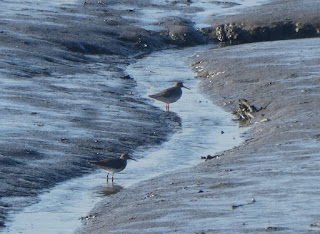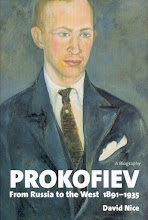I doubt if the saint ever stamped around this part of Ireland's glorious west coast in any sense (the Catholics will be after me), but Croagh
Patrick (Irish: Cruach Phádraig, meaning 'Patrick's stack',
nicknamed 'the Reek') in County Mayo, with a peak at 764 metres, makes a fine place of pilgrimage. We didn't make it to the top, making only a fair part of the ascent, since on the glorious Friday of our visit, the mountains were all covered in snow from the previous day's blizzards (seen on the coast-to-coast train journey from Dublin to Westport), a rare occurrence, First glimpses of Croagh Patrick so coated were awe-inspiring, and even more so from Westport Harbour, first stop on friend Justin's chauffering of us about the place.
Westport proper is about a mile or so inland, one of the few 'planned towns' in Ireland dating from 1767, when John Browne, later first Earl of Altamont, advertised its foundation, with the Carrowbeg river turned into a tree-lined central canalisation
and a pretty octagon on which our hotel sat, Patrick atop the column since 1990.
The 'planned town' went into a swift decline along with that of the textile industry and the arrival of the famine, but it's remained a pleasant backwater, good (if you want) for shopping and eating. The most exciting emporium for me was the very individual bookshop on the Quay, Tertulia.
It was - I have to stress again - our exceptional good fortune to look out from this neck of Clew Bay to mountains covered in snow. From my map, I can't quite work out what I'm seeing here - the mountainous bit of Clare Island, perhaps (hoping Justin will eventually help out).
I'll also need some help with bird identification. Clearly this is a lone Curlew (and we heard many more calls),
and these Redshanks,
but the beak on this one is too long for an ordinary Dunnock. Any suggestions? Looks more like a Warbler or Chiffchaff, but do they frequent seaweed and kelp?
The river channels were rich with birdlife a couple of days later, but the main interest that Friday was in the boats, this one
named after the fascinating figure of 'Queen' Grace (Gráinne) O'Malley, head of the clans hereabouts in the 16th century, who met with Elizabeth I in London and refused her gifts. There's a (recent) statue to her in the grounds of Westport House; the former inhabitants claimed (dubious) descent from her.
Clew Bay is rich in crustaceans, as this informative board to which Justin is directing our attention makes clear, though the famous muscles come from Killary Fjord further south, where we walked during our time at the best of weddings, David's and Gwendolen's, in Connemara back in 2011.
I think we're looking over here to Nephin Beg range
but our pressing destination was Croagh Patrick, and we didn't have to ascend much to have spectacular views of bays and mountains.
The mountain is composed (thank you, Geological Heritage Sites of Mayo), of 'metamorphosed sedimentary rocks (originally formed during the Silurian Period some 435 million years ago) including quartzites',
and abundant green serpentite - Justin pointed out whole rocks of it, but there's some in here, I think.
He also told us there was plentiful gold in this here hill, but no way will permission ever be given to mine for it.
The summit looked a long way distant
but we could probably have made it further, since the thaw was already beginning, if Justin didn't need to get back for afternoon preparation of the big evening supper. So four more shots on the way down
After a rest back at the hotel, I was keen to make the most of our one perfect day (plentiful rain was forecast), so we climbed out of town
to follow the start of the Great Western Greenway (disused railway line)
with more fine views of Croagh Patrick to our left
to have a snack overlooking the bay and mountain.
Supper, it goes without saying, was extremely convivial, and we met more splendid people, two of whom we'd have tea and lunch with over the next few days. Saturday was wet and windy and, by the time we crossed the bridge to Achill Island, ferociously cold outside the car, with the water of Achill Sound a very different colour as we looked across to Cnoc an Chorráin (Corraun, or Carrane, or Curraun, Hill, 524m), on which some snow still remained
All that remained to make the view even more rugged and dramatic in the blasting wind was the 15th century tower house known as Kidavnet Castle. Built in 1429, its fame remains as another stronghold of our Pirate Queen.
A lifeboat station is crucially positioned a little further along - here's one of the boats from inside the tower.
Glad to be chauffered in the dramatic weather, and not making our way round the island on foot, we rounded to the wild west opening out on to the Atlantic Ocean. Two more necessary stops, one for this dramatic cleft
on one ledge of which a colourful local sheep was lodged (on closer inspection, not trapped)
Peat moors to the right, officially protected but still often resourced, then looking across to the cliffs at Dumha Éige.
Much-needed refreshment at the beautifully-designed home of writer and BAFTA award-winning filmmaker Kevin Toolis, whose book on the IRA and
My Father's Wake – How The Irish Teach Us To Live, Love and Die I'm about to read, at Dookinella. This article gives a very good flavour of the man, Looking out to the long beach at Trawmore
and through another window to the Cathedral Rocks.
The plan had been to go for a walk, but the rain was lashing down now, so we went for a further drive, via
Heinrich Böll's cottage, now offering two-week residencies to writers and artists, and the tree-girt Achill Colony founded by Protestant Edward Nangle near Dugort (I'd love to join one of Kevin's tours around it). Our next stop-off was at the studio of Redfoxpress,
looking across the bay to Slievemore (772m)
The singular bookmakers here are Belgian Francis Van Maele and Korean Hyemee Kim, aka Antic-Ham, whose illustrations are precious. I already knew I coveted the book she'd worked on with Manchán Magan, inspirational curator of Irish words, Sea Tamagotchi.
A
continuation of Magan's idea for giving special native words to people to take care of, like the original tamagotchi, it's the product of his journey along the coast roads of Mayo, Donegal,
Sligo and Galway, seeking out forgotten sea words, maritime terms and coastal customs.
The 38 here are accompanied by Antic-Ham's drawings, collages and photographs. I'm entranced by so many, but especially the image for 'Caibleadh (Cab-loo): spirit voices heard in the distance at sea on calm nights', on the right below.
I asked about the problem of keeping paper unfoxed in such a damp climate, and that's precisely why one book is produced at a time; when it's sold, they make the next one.Kevin advised us to ask to see the shed, which turned out to be full of polaroid cameras (as in one wall of the studio).
Our artists heading back from shed to studio.
Last stop on Achill Island, a long-delayed stop at Ted's Bar, a spacious epicentre for eating and entertainment, with one sign indicating where a lot of the Achilleans went,
and then tea with new friend Rosemary (and her soppy Hungarian schnauzer Bartok) outside Newport.
Sunday gave us a chance to see inside Westport's rather interesting Holy Trinity, consecrated in 1872 and designed upon Ruskinesque principals, the priotity being airiness, in which the architect certainly succeeded.
Thus the west end, with its fine rose window, and this the east
The main designs were traced in marble and inlaid with black cement.
Some of the stone carving is rather good too, especially so in the case of this door.
We'd been encouraged by another new friend, Benita, to come and hear the local Archibishop, who was indeed rather good (I'd been aiming to slip in at the end, just to see the church, but everything had started half an hour later so I caught the end of the sermon). Later Benita gave us lunch, up another beautiful creek near Newport, with its fair share of remaining rainforest, though once again the weather was vile, so we didn't do much walking.
Fortunately the rain cleared away late on Monday morning, and as our train back to Dublin wasn't until after 6pm, there was time to do an extended circuit from town to harbour via the grounds of Westport House - fortunately still giving access to pedestrians even if the house, under new ownership, is currently shut - and back via the Greenway. Spring blossom was only to be found in sheltered zones, like the banks of the Carrowbeg in the grounds.
Then the not especially attractive house came into view.
Looks better from a distance, as part of the landscape
and on the other side the Carrowbeg leads out to the harbour.
This time the bird life was abundant - or rather, the variety was. More Redshanks,
a lone Oystercatcher,
Wigeons swimming and on the banks,
a solitary Little Egret,
and possibly the same Curlew in the bay.
Snow had now vanished off all the surrounding mountains.
but there were also more signs of spring.
An extended walk around the nearest peninsula wasn't quite what I expected at first - luxury gated houses either side of the road - but became lovelier towards the end, and a stonewalled, treelined mini road to the south opened out on to more bay and Croagh Patrick, with darker skies behind.
Time was running out, so I made for the Great Western Greenway back, lichen and pools to the left
and mountain again to the right, leafing in the foreground,
with a final enlivening by a noisy call from a Chaffinch
before reaching the town and setting off for the station. A bracing time away indeed.








































 ,
, 






































